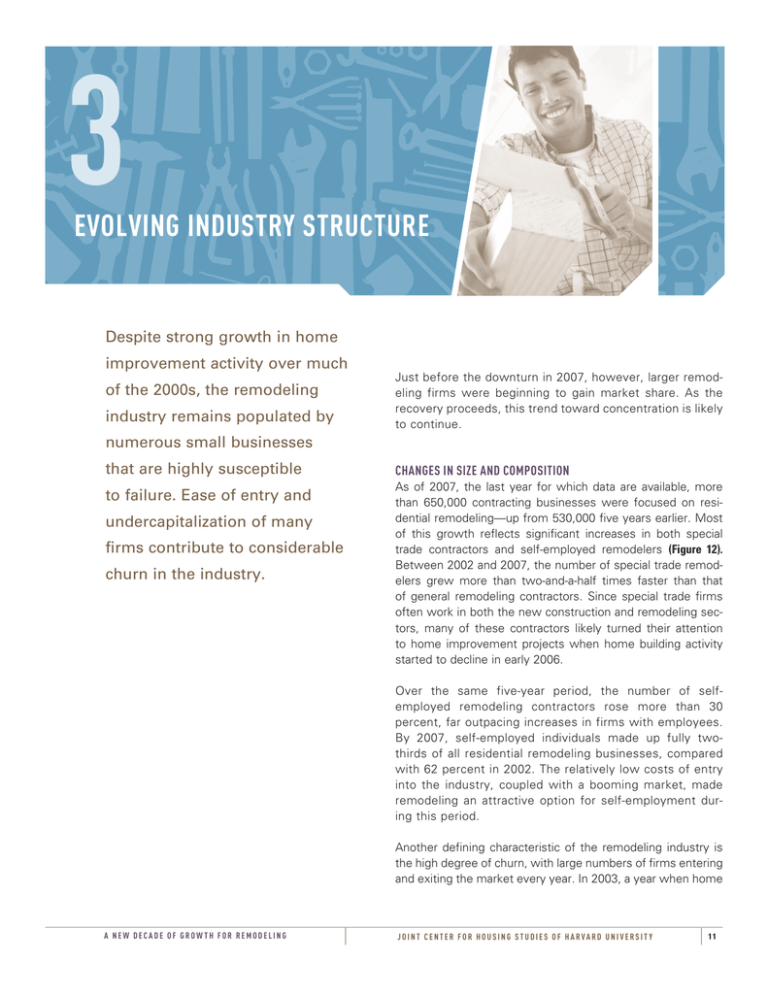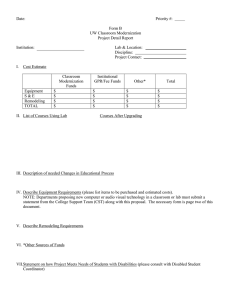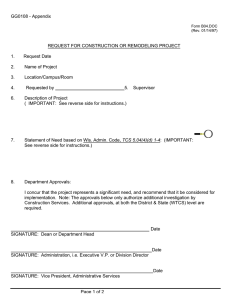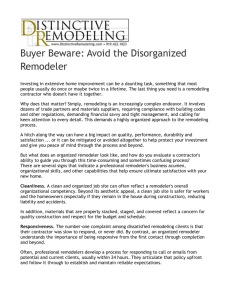3 EVOLVING INDUSTRY STRUCTURE Despite strong growth in home improvement activity over much
advertisement

3 EVOLVING INDUSTRY STRUCTURE Despite strong growth in home improvement activity over much of the 2000s, the remodeling industry remains populated by Just before the downturn in 2007, however, larger remodeling firms were beginning to gain market share. As the recovery proceeds, this trend toward concentration is likely to continue. numerous small businesses that are highly susceptible to failure. Ease of entry and undercapitalization of many firms contribute to considerable churn in the industry. CHANGES IN SIZE AND COMPOSITION As of 2007, the last year for which data are available, more than 650,000 contracting businesses were focused on residential remodeling—up from 530,000 five years earlier. Most of this growth reflects significant increases in both special trade contractors and self-employed remodelers (Figure 12). Between 2002 and 2007, the number of special trade remodelers grew more than two-and-a-half times faster than that of general remodeling contractors. Since special trade firms often work in both the new construction and remodeling sectors, many of these contractors likely turned their attention to home improvement projects when home building activity started to decline in early 2006. Over the same five-year period, the number of selfemployed remodeling contractors rose more than 30 percent, far outpacing increases in firms with employees. By 2007, self-employed individuals made up fully twothirds of all residential remodeling businesses, compared with 62 percent in 2002. The relatively low costs of entry into the industry, coupled with a booming market, made remodeling an attractive option for self-employment during this period. Another defining characteristic of the remodeling industry is the high degree of churn, with large numbers of firms entering and exiting the market every year. In 2003, a year when home A NEW DECADE OF GROWTH FOR REMODELING JOINT CENTER F OR HOUSING STUDIES OF HARVARD UNIVERSIT Y 11 improvement spending was growing strongly nationwide, nearly 18 percent of all general remodeling firms with payrolls were startups. With so many self-employed contractors and startup firms, it is not surprising that the remodeling industry remains heavily weighted toward smaller businesses. More than 70 percent of self-employed remodelers in 2007 had revenues of less than $100,000. Even contractors with payrolls tend to be smaller operations, with nearly half generating less than $250,000 in revenue that year. At the same time, though, the share of larger payroll firms with revenues over $500,000 climbed from 22 percent to almost 30 percent. The redistribution of firms was especially evident in the $1 million or more revenue category, where the share increased from less than 10 percent in 2002 to about 15 percent in 2007. Figure 12 During the Housing Boom, the Number of Self-Employed Remodelers Grew Substantially Number of Remodelers Percent Change 2002 2007 2002–7 82,900 77,900 -6.0 Self-Employed 127,200 156,700 23.2 Total General 210,100 234,600 11.7 General Contractors Payroll Special Trade Contractors Payroll 117,200 139,500 19.0 CONCENTRATION TRENDS Self-Employed 202,900 278,100 37.1 Although the largest firms still made up a relatively small share of remodeling establishments in 2007, they were responsible for a substantial and growing share of industry activity (Figure 13). In that year, general and special trade remodelers with revenues of at least $1 million accounted Total Special Trade 320,100 417,600 30.5 Total 530,200 652,200 23.0 Note: Includes self-employed remodeling contractors with annual revenues of at least $25,000. Source: JCHS estimates using unpublished tabulations from US Census Bureau, 2002 and 2007 Economic Census of Construction and Nonemployer Statistics. Figure 13 Larger Remodeling Establishments Captured a Growing Share of Jobs, Material Purchases, and Receipts in 2007 Shares of industry totals (Percent) 70 60 50 40 30 20 10 Under $250,000 ■ 2002 ■ 2007 $250,000–999,999 ts cei p Re M Pu ater rch ial ase s nt me plo y Em nts abl ish me Est cei pts Re M Pu ater rch ial ase s nt me plo y Em nts Est abl ish me pts cei Re ent loy m M Pu ater rch ial ase s Est abl Em p ish m ent s 0 $1 Million and Over Annual Receipts Source: JCHS estimates using unpublished tabulations from US Census Bureau, 2002 and 2007 Economic Census of Construction. A NEW DECADE OF GROWTH FOR REMODELING JOINT CENTER F OR HOUSING STUDIES OF HARVARD UNIVERSIT Y 12 for 55 percent of total employment, 65 percent of material purchases, and 66 percent of remodeling and repair receipts. Given the dramatic increase in revenue among larger establishments, it is not surprising that the remodeling industry became somewhat more concentrated during the housing market upturn. companies accounted for 7.9 percent of industry revenue in 2007, while the top 50 auto repair firms received just 6.4 percent. In contrast, the top 50 food service companies generated more than 20 percent of industry revenues. Inflation aside, though, larger firms clearly played a more dominant role in the remodeling market over this period. Indeed, the top 50 general remodeling contractors accounted for almost 8 percent of total receipts at payroll firms in 2007, up from 5.2 percent in 2002 (Figure 14). The increased concentration of larger remodeling firms between 2002 and 2007 may indicate that the industry is mirroring shifts that have occurred in the home building industry. Remodeling firms have traditionally been similar in structure to home building companies, with many smallscale operations and high levels of business failures. During the 1990s and early 2000s, home builders began acquiring other companies in an effort to expand their land positions and enter new markets. So far, though, remodeling companies do not face similar pressures to consolidate, although the magnitude of the recent downturn may have provided further impetus. Nevertheless, consolidation would offer remodelers important benefits of scale, such as greater operating efficiencies and better negotiating positions with suppliers—not to mention stronger balance sheets to help bridge down cycles. Compared with other industries where many small businesses serve a limited geographical area, remodeling is just as fragmented as auto repair but significantly less concentrated than food services. As noted, the top 50 general remodeling Despite signs of increased concentration among large firms, the steady influx of many small and self-employed Some of the industry concentration may, however, be an artifact of inflation pushing sales into higher revenue categories. Overall consumer prices rose 15 percent between 2002 and 2007, and remodeling costs may have increased even more because strong homeowner demand allowed contractors to compete less on pricing. As a result, a firm may have been able to grow receipts of $400,000–450,000 in 2002 to $500,000 in 2007 without increasing its workload. Figure 14 INDUSTRY CHURN AND BUSINESS SURVIVAL Figure 15 Concentration of the Remodeling Industry Increased Through 2007 Failure Rates for Remodeling Firms Were High Even During the Market Upturn Share of receipts for largest remodeling contractors (Percent) Share of establishments in 2003 no longer operating in 2007 (Percent) 8 7.9 7 6 60 53.6 50 5 5.2 5.2 4 3 3.4 2.5 2 1 30 3.3 Top 8 Top 20 Top 50 Remodeling Contractors 2002 25.4 20.2 14.7 10 Top 4 ■ 42.6 36.3 20 2.1 1.4 0 40 ■ 2007 Source: JCHS estimates using unpublished tabulations from US Census Bureau, 2002 and 2007 Economic Census of Construction. 0 All Startups 2003 Establishments Under $250K $250– 499K $500– 999K $1M and Over Estimated 2003 Receipts Note: Failure rates were calculated by 2003 payroll categories, where under $250,000 in receipts corresponds to less than $50,000 in payroll; $1 million and over in receipts corresponds to more than $250,000 in payroll. Source: JCHS estimates using US Census Bureau tabulations of the Business Information Tracking Series. A NEW DECADE OF GROWTH FOR REMODELING JOINT CENTER F OR HOUSING STUDIES OF HARVARD UNIVERSIT Y 13 remodelers adds to overall industry fragmentation. As a result, general remodeling contractors have relatively high failure rates (Figure 15). According to Joint Center analysis of national business statistics data, more than a third of general remodelers with payrolls operating in 2003 were no longer in business just four years later. Given that such a high percentage of firms exited the industry during a period of healthy growth, failure rates have likely soared since the severe market downturn. According to a 2009 member census by the National Association of Home Builders, 45 percent of single-family home builders listed residential remodeling as a secondary activity—by far the largest share reported among several diversification choices. The next most popular secondary activities were land development (15 percent), planning or designing (10 percent), and commercial contracting (7 percent). The less volatile remodeling market thus provides a popular fall-back option, particularly for smaller home building firms. Previous Joint Center research found that size, age, and recent performance are important determinants of business survival. Small remodelers, young businesses, and those with declining revenue are significantly more likely to fail in any given year. While 36 percent of all remodeling firms exited the industry between 2003 and 2007, fully half of startups in 2003 did not survive through 2007. More than 40 percent of establishments with less than $250,000 in revenues also failed. Again, the relationship between establishment size and survival is clear, with remodelers earning $1 million or more in revenues in 2003 having considerably lower failure rates. The past few years have clearly been challenging for residential remodelers. Industry payroll employment peaked at more than 310,000 in 2007 and then fell more than 25 percent by the latter half of 2010. Homeowner improvement spending also dropped by more than 23 percent from its 2007 peak, but began to stabilize in 2010—indicating that remodeling employment may soon stabilize as well. Since 2007, remodelers have not only struggled with dramatic declines in homeowner spending but also the pressure of increased competition from builders-turned-remodelers. With the recent collapse of residential construction activity, many home builders turned to the remodeling market as they waited out the housing recovery. For many builders, focusing on remodeling is a relatively easy and attractive way to diversify. IMPACTS OF THE RECESSION Even the largest remodeling firms saw significantly weaker performance between 2007 and 2009. According to analysis of Qualified Remodeler magazine’s annual top 500 remodelers list, revenue growth for large companies began to slow in 2005 before dropping sharply in 2008 and 2009 once the market downturn was fully under way. While half of large firms reported revenue declines of less than 4 percent in 2008, the median decline rose to more than 9 percent in 2009. Figure 16 Contractors Specializing in Exterior Replacements Fared Best During the Downturn Median annual change in remodeling revenue for top 500 remodelers (Percent) 15 10 5 0 -5 -10 -15 -20 -25 2003 ■ Design/Build 2004 ■ Full-Service ■ 2005 2006 2007 2008 2009 Exterior Replacements Notes: Analysis includes remodelers reporting revenue in any two consecutive years and ranking in the top 400 in at least one of those years. Full-service remodelers include kitchen and bath specialists. Source: JCHS tabulations of Qualified Remodeler magazine’s Top 500 Remodelers. A NEW DECADE OF GROWTH FOR REMODELING JOINT CENTER F OR HOUSING STUDIES OF HARVARD UNIVERSIT Y 14 Business performance varies by remodeling specialty. During the boom years, revenue growth among design/build and full-service firms outpaced that for exterior replacement contractors. But as homeowners cut back on higher-end discretionary projects such as major kitchen and bath remodels and room additions, revenue declines for design/build and fullservice firms were especially sharp. Indeed, the median drop in receipts for design/build firms was more than 20 percent in 2009, while that for exterior replacement firms was less than 5 percent (Figure 16). In addition to more stable demand, contractors specializing in exterior replacements benefited from provision of federal tax credits for projects designed to improve home energy efficiency. EMERGING OPPORTUNITIES FOR REMODELERS As the industry begins to recover, remodeling firms are surviving the down market by diversifying their services. For example, design/build firms are taking on smaller-scale projects while many full-service contractors are offering handyman or restoration services. Remodelers also have moved A NEW DECADE OF GROWTH FOR REMODELING into niche markets, such as energy-efficient improvements and other types of green remodeling, rehabilitation of distressed properties, or adaptive retrofits to homes of seniors who want to age in place. Contractors are also using this time to update their information technology and communications systems, and focus more on marketing and branding to attract new customers. During the housing boom years, the number of remodelers grew rapidly as new contractors entered the market to take advantage of soaring demand. But the sharp retreat in home improvement spending likely put many smaller operations out of business. Potential new entrants now see the risks associated with the highly cyclical construction and remodeling industries. This has opened up opportunities for larger and more stable remodeling firms to capture a larger share of spending as the market recovers. In the years ahead, industry concentration is likely to continue as large firms become more specialized and therefore more efficient, and as customers increasingly value the benefits of more established professional remodeling operations. JOINT CENTER F OR HOUSING STUDIES OF HARVARD UNIVERSIT Y 15



